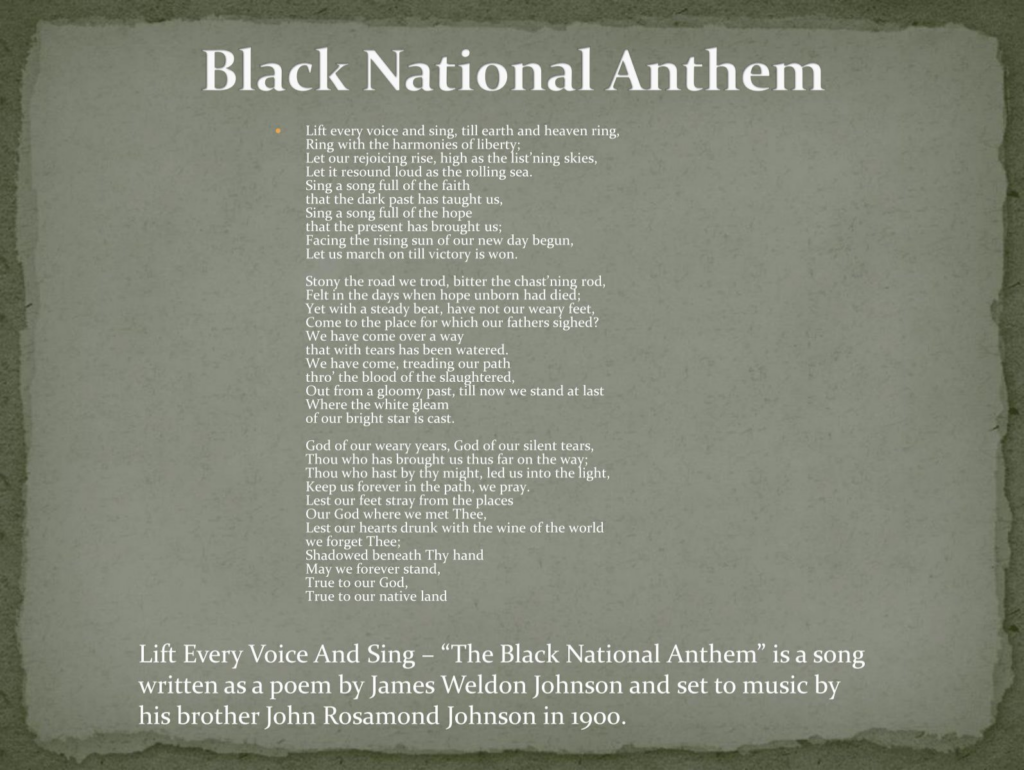|
Getting your Trinity Audio player ready...
|
Introduction: The Enduring Legacy of “Lift Every Voice and Sing”
“Lift Every Voice and Sing,” widely known as the Black National Anthem, stands as a timeless testament to African American resilience, hope, and cultural identity. Born at the dawn of the 20th century, this powerful hymn has woven itself into the fabric of American history, resonating through generations of struggle and progress. From its humble origins as a school song to its status as a national cultural treasure, “Lift Every Voice and Sing” continues to inspire, unite, and provoke thoughtful discourse on the journey toward equality. This exploration delves into the anthem’s rich history, its profound impact, and its enduring relevance in an ever-evolving society.
Origins and Early History

James Weldon Johnson, a 28-year-old educator and civil rights activist, wrote the lyrics to “Lift Every Voice and Sing” in 1900. At the time, Johnson was already an accomplished figure in Jacksonville, Florida, having graduated from Atlanta University, passed the Florida bar, founded the state’s first African-American newspaper, and become principal of Stanton School12. The song was created for a specific occasion – a celebration of Abraham Lincoln’s birthday on February 12, 1900, at the Stanton School in Jacksonville, Florida. Johnson, who was the school’s principal, wanted to offer something special for the event. He initially considered writing a poem about Lincoln but felt he didn’t have enough time to do it justice2. Instead, Johnson collaborated with his brother, John Rosamond Johnson, to create a song. James wrote the lyrics, while Rosamond composed the music. The brothers worked on the song in their LaVilla home, with James pacing on the porch as he crafted the powerful words2.
The First Performance
On February 12, 1900, “Lift Every Voice and Sing” was performed for the first time by a choir of 500 schoolchildren at the Stanton School1. The performance was a highlight of the Lincoln birthday celebration, marking the beginning of the song’s journey to becoming an anthem2.
Spread and Adoption
After its initial performance, the Johnson brothers moved to New York in 1901, and the song temporarily faded from their minds. However, the impact of the song on the schoolchildren who first performed it was lasting. These children continued to sing the song, took it with them to other schools, and some even became teachers who taught it to their pupils23. The song’s popularity grew organically, spreading through schools and churches across the country. By 1905, it had gained the endorsement of prominent African American leader Booker T. Washington3. In 1919, the National Association for the Advancement of Colored People (NAACP) officially adopted “Lift Every Voice and Sing” as its official song14.

Significance and Meaning
The lyrics of “Lift Every Voice and Sing” resonate deeply with the African American experience. They speak to the struggles and triumphs of Black Americans, acknowledging the “dark past” while expressing hope for the future. The song calls for unity and perseverance in the face of adversity12. James Weldon Johnson later reflected on the creation of the song in his autobiography, “Along This Way.” He described the process as one of “agony and ecstasy,” noting that by the third stanza, he found himself in a state of poetic euphoria, weeping as he crafted the lines2.
Cultural Impact
Over the decades, “Lift Every Voice and Sing” has become deeply ingrained in African American culture. It has been sung in churches, schools, and at civil rights gatherings. The song gained particular prominence during the Civil Rights Movement of the 1950s and 1960s, serving as a rallying cry for equality and justice7.The hymn has been performed by numerous artists over the years, including notable figures such as Ray Charles, Beyoncé, and Alicia Keys. Its performance at major events, such as presidential inaugurations and sporting events, has further cemented its status as an important cultural touchstone6.
Contemporary Relevance
In recent years, “Lift Every Voice and Sing” has experienced a resurgence in popularity and visibility. This renewed interest has been partly driven by increased awareness of racial issues in the United States and a desire to celebrate African American culture and history. The song has been featured at high-profile events, including:
- Beyoncé’s 2018 Coachella performance
- The opening of the Smithsonian National Museum of African American History and Culture in 2016
- Various NFL games, starting in 2020 following the George Floyd protests
Controversy and Debate
The increased prominence of “Lift Every Voice and Sing” has also sparked some controversy, particularly regarding its performance at sporting events alongside the U.S. National Anthem. Some view the inclusion of the Black National Anthem as a positive step towards acknowledging African American history and culture, while others argue that it’s divisive or unnecessary. This debate reflects broader societal discussions about race, representation, and national identity in America. It highlights the ongoing struggle to reconcile the nation’s diverse cultural heritage with its aspirations for unity.
Musical and Poetic Analysis
Musically, “Lift Every Voice and Sing” is characterized by its soaring melody and powerful harmonies. The song is typically performed in a slow, dignified tempo, emphasizing its hymn-like qualities. The melody rises and falls, mirroring the emotional journey described in the lyrics. Poetically, the song is rich in imagery and metaphor. It uses natural elements like earth, sky, and stars to evoke a sense of universality and timelessness. The lyrics also employ religious language and themes, reflecting the important role of faith in African American communities.
Legacy and Continuing Influence
The enduring legacy of “Lift Every Voice and Sing” is a testament to its power and relevance. It continues to be taught in schools, performed at cultural events, and used as a tool for education about African American history and culture.The song has inspired numerous works of art, literature, and music. For example, in 1937, sculptor Augusta Savage created a piece called “The Harp” for the World’s Fair, inspired by “Lift Every Voice and Sing.” Although the sculpture was sadly destroyed after the fair, its creation demonstrates the song’s impact on African American art and culture1.
Key Points
- What it is: “Lift Every Voice and Sing” is often called the Black National Anthem due to its historical importance to Black culture in the U.S.3. It’s a hymn that highlights the struggles and hopes of Black Americans6.
- Origins: James Weldon Johnson wrote it as a poem in 1899 for Abraham Lincoln’s birthday, and his brother John Rosamond Johnson composed the music12. It was first performed by 500 Black students at a segregated school in Jacksonville, Florida12.
- NAACP Connection: In 1919, the NAACP adopted it as their official song, solidifying its role as a key part of Black cultural identity14. James Weldon Johnson was a leader in the NAACP78.
- Civil Rights Movement: The song became a rallying cry during the Civil Rights Movement26.
- NFL and Controversy: The NFL began playing “Lift Every Voice and Sing” before games in 2020 to “show commitment to diversity”13. This sparked controversy, with some conservatives objecting to a separate anthem157.
- Recent Performances: Grammy winner Ledisi will sing “Lift Every Voice and Sing” at Super Bowl 591. Andra Day sang it at Super Bowl 587.
- Enduring Message: The song calls for the liberation of Black Americans and promotes unity7.
Conclusion
“Lift Every Voice and Sing” stands as a powerful symbol of African American resilience, hope, and cultural identity. From its humble beginnings as a school song to its status as the Black National Anthem, it has played a significant role in American history and continues to resonate with audiences today. As debates about its place in public life continue, the song remains a poignant reminder of the struggles and triumphs of African Americans and a call for unity and perseverance in the ongoing fight for equality.


